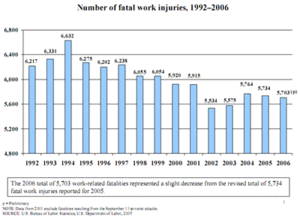
Since the early 1990's, most companies have got their act together and decreased their workplace injuries (see chart). After all, it's a no-brainer that workplace...
 Recently, I was talking to a safety consultant who told me about a business he visited a while ago that had staff handling pieces of wood with multiple nails sticking out, while not wearing gloves.
Recently, I was talking to a safety consultant who told me about a business he visited a while ago that had staff handling pieces of wood with multiple nails sticking out, while not wearing gloves.
Every day these employees were constantly subjecting their hands to pain, yet, no-one complained.
What's interesting about human behaviour is that when we are in physical pain the body will learn to adapt and avoid it.
Think about the last time you had a sore tooth. You automatically started eating on the other side of your mouth.
In this company where people were ignoring the daily pain of work, they just got used to it because everyone else was doing it and nobody protested. Management was okay and would have been open to suggestions (provided enough people let them knew of the issue).
Often, people will get so used to the pain they are in that they just don't notice it. It's easier for them to put their head in the sand and not even think about the pain, even if they are not happy about it.
The safety consultant even questioned some employees as to why they were putting up with the pain, but he just got the response that it wasn't a big deal.
Interestingly, humans are designed to avoid painful situations and move towards gainful. According to Maslow's Hierarchy of Needs, we are programmed to want freedom from fear, pain and danger. We intrinsically want to work in companies that will keep us safe from harm.
However, sometimes we don't feel that things will change or that by speaking up we will be in even more danger. This is what keeps people trapped. However, the good news is that because we are programmed to want to be pain free, you can tap into people's deep seated need to be safe.
Changing the Safety Mindset
When it comes to employees working unsafely or not even caring about their safety, the way to bring it to their attention is to make it active in their neurology. Instead of them deleting the pain, you need to bring it to the forefront of their mind. You need to stop them from pretending that it isn't a big deal.
The only way to break employees out of their complacency is to make them aware of the pain in a crystal clear way. To bring it to the top of mind, you need to start by asking feeling words such as "How does it feel to handle lumps of dry wood every day with nails that cut your hands?"
Or if they are working unsafely and in denial about the danger they are putting themselves into ask, "How do you think you'd feel if you lost your foot because you weren't being careful with the chainsaw?"
Essentially, you need to ask questions that make people aware of the level that they're at. Then, you need to paint a picture of the possibilities. What the future would look like if they made a change. For example, by asking: "So what do you think it would be like to come home from work everyday without cuts on your hands?"
You need to make them aware of the gap between where they are now and where they really want to be (or in this case, need to be). Call them to a higher place and tap into their emotions. The real trick is for them to tell you, rather than you tell them.
What a lot of safety professionals do is go into lots of detail about why people should avoid the dangerous behaviour. Or tell people off and let them know they are wrong or stupid (or both). This only creates overwhelment and the potential for disagreement. It almost certainly guarantees that they won't change.
When you change someone's attitude, you change their destiny. As a safety leader, you need to have the safety communication skills to encourage people to work at the optimum level. You need the skills to influence your workplace to buy into the company's safety vision.
What are you doing to learn how to change someone's attitude to safety? Your first step is to attend my free webinar, 3 Secret Strategies to Inspire Effective Action on Your Safety Messages.
Photo credit, Marin, freedigitalphotos.net

Since the early 1990's, most companies have got their act together and decreased their workplace injuries (see chart). After all, it's a no-brainer that workplace...

Everything we do is communication. And it is no wonder that research studies point to 70% of workplace mistakes being caused by poor communication.
How we start our...